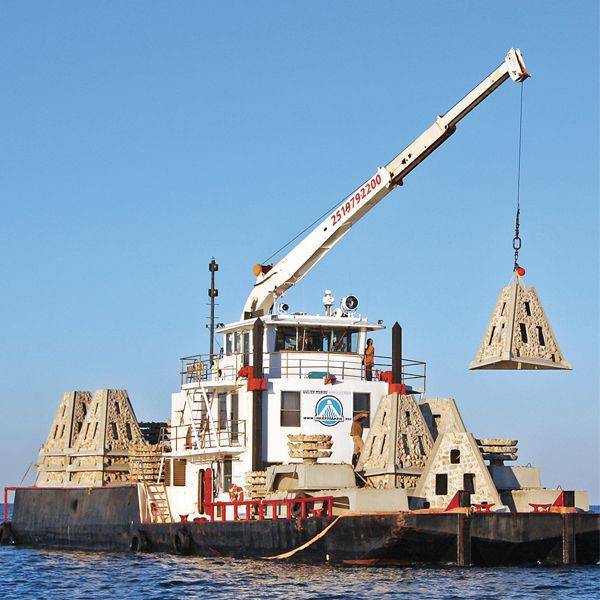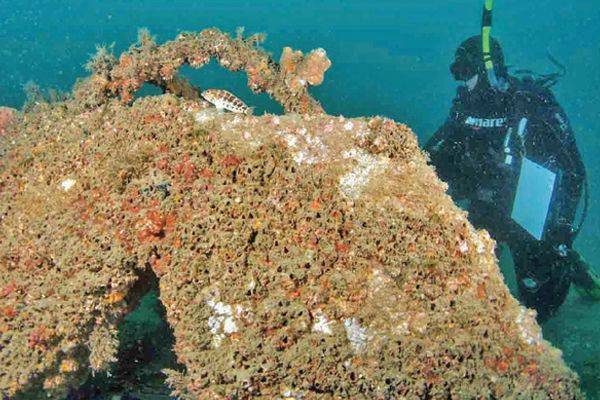By Carol Cox
[dropcap]W[/dropcap]hen it comes to building reefs, there are as many opinions on how it should be done as there are artificial reef designs. For every boater that would like to see reefs placed within easy running distance from the boat launch, there is another who wants the reefs in deeper water where they may accommodate bigger fish. For every person who believes reefs provide places for fish to congregate making them easier to overfish, there are others who believe artificial reefs take fishing pressure off the natural reefs and provide valuable habitat to increase the fish population. Some fishermen want reef structures clustered close together to make them easy to find and bottom fish, while others preferred the structures spread out for trolling.
The Mexico Beach Artificial Reef Association (MBARA) works hard to satisfy as many fishermen and divers as possible. What many people don’t realize is the incredible amount of planning and work that goes into building an artificial reef.
The first step is to have a reef permit in hand, a process that can easily take 2 years to accomplish. The permit applicant has to be a government agency, such as a city or county. When choosing a location, there are many considerations–the permit area can’t be near shipping lanes, drone launch areas, marine preserves, or over hard bottom. The application undergoes extensive review and comments are solicited from the public. It has to be approved by the Army Corp of Engineers, and when State waters are involved, the Florida Department of Environmental Protection.
A permit specifies coordinates for the permitted area, materials that can be used, and minimum clearance requirements to keep the waters safe for boats and ships. Materials must be durable, stable, and nonpolluting. Older ships were once considered ideal for use as artificial reefs, but now require extensive clean-up to remove sources of PCBs, lead, and pollutants such as petroleum products. They also have to be made reasonably safe for divers and marine life. Old tires were once popular, but many washed up on the beaches during major storms, plus marine growth could not take hold on the rubber. Because of challenges like these, some of the most popular artificial reefs today are prefabricated concrete and heavy-steel structures. Reefs can be made with PH-balanced concrete that matches natural limestone reefs and may include large chunks of limestone soft enough for marine organisms to quickly take hold.
Once a permit is in hand, the labor and time consuming chores of fund-raising, writing grant requests, and awarding contracts come into play. This work is often accomplished by a few dedicated volunteers.
Before deployment at sea, a two-week notification is provided to several agencies so they can inspect the materials if they have concerns. Once the structures are deployed, these same agencies are given a placement report that provides the coordinates and depths of the new reefs.
MBARA has a small team of research divers who make it a goal to survey at least 25 artificial reef sites a year. These surveys provide valuable information on what kinds of structures are stable on sandy bottoms and what designs work best to mimic natural reefs for sea life. They have tried a variety of different designs and find some interesting trends. For instance, by placing different types of structures together, they find a much greater diversity of marine life. This might include a pyramid, a layer-cake shaped ecosystem, and a rectangular grouper module. Ecosystems are also great for protecting juvenile fish, including small groupers, and also are a favorite place for Black seabass to congregate. Some reef balls and rectangular reefs aren’t faring well in shallow, sandy areas, so MBARA is experimenting with pyramids, ecosystems on pilings drilled into the sand, and ecosystems attached to rectangular grouper reefs. Only time will tell which designs will endure and perform best. MBARA recently received a grant from the State to experiment with new 20-foot tall pyramids called Super Reefs. These reefs have to go in deeper permit areas because of the minimum water column clearance requirements for navigation safety. It is hoped these reefs will quickly become thriving ecosystems for popular game fish such as snappers, groupers, and amberjacks. They are almost certain to become homes to protected species such as Goliath groupers and Sea turtles.
With few exceptions, coordinates for artificial reefs are posted on the Florida FWC artificial reef website. However, a few reef sites are left unpublished. These sites are known as refugia reefs, and their purpose is to have sites with less fishing pressure, hopefully to help replenish fish on published reefs. These are not Marine Protected Areas, and can be fished by anyone lucky enough to find them.
If you would like to learn more about building artificial reefs, and want to have a say on the future of how reefs are deployed, you should attend meetings of your local artificial reef organization. For the City of Mexico Beach, that organization is the Mexico Beach Artificial Reef Association or MBARA. MBARA is one of the most active and successful artificial reef organizations in Florida, but there are a number of other reef-building organizations in the Panhandle. These include the Organization for Artificial Reefs in Franklin and Wakulla Counties, the Emerald Coast Reef Association in Destin, and the newly formed Bay County Artificial Reef and South Walton Artificial Reef Associations. For more information on building artificial reefs, visit the FWC’s Artificial Reef Program.



